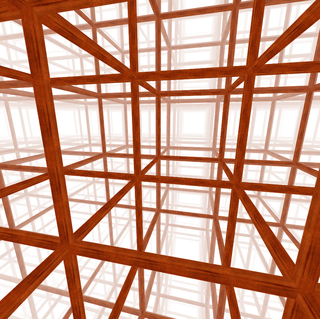
The cubic honeycomb or cubic cellulation is the only proper regular space-filling tessellation in Euclidean 3-space made up of cubic cells. It has 4 cubes around every edge, and 8 cubes around each vertex. Its vertex figure is a regular octahedron. It is a self-dual tessellation with Schläfli symbol {4,3,4}. John Horton Conway called this honeycomb a cubille.

In seven-dimensional geometry, a 7-polytope is a polytope contained by 6-polytope facets. Each 5-polytope ridge being shared by exactly two 6-polytope facets.

In four-dimensional Euclidean geometry, the 16-cell honeycomb is one of the three regular space-filling tessellations, represented by Schläfli symbol {3,3,4,3}, and constructed by a 4-dimensional packing of 16-cell facets, three around every face.
In geometry, the 5-cubic honeycomb or penteractic honeycomb is the only regular space-filling tessellation in Euclidean 5-space. Four 5-cubes meet at each cubic cell, and it is more explicitly called an order-4 penteractic honeycomb.
The 5-demicube honeycomb is a uniform space-filling tessellation in Euclidean 5-space. It is constructed as an alternation of the regular 5-cube honeycomb.
In geometry, the 222 honeycomb is a uniform tessellation of the six-dimensional Euclidean space. It can be represented by the Schläfli symbol {3,3,32,2}. It is constructed from 221 facets and has a 122 vertex figure, with 54 221 polytopes around every vertex.
In four-dimensional Euclidean geometry, the 4-simplex honeycomb, 5-cell honeycomb or pentachoric-dispentachoric honeycomb is a space-filling tessellation honeycomb. It is composed of 5-cells and rectified 5-cells facets in a ratio of 1:1.

In five-dimensional Euclidean geometry, the cyclotruncated 5-simplex honeycomb or cyclotruncated hexateric honeycomb is a space-filling tessellation. It is composed of 5-simplex, truncated 5-simplex, and bitruncated 5-simplex facets in a ratio of 1:1:1.
In five-dimensional Euclidean geometry, the omnitruncated 5-simplex honeycomb or omnitruncated hexateric honeycomb is a space-filling tessellation. It is composed entirely of omnitruncated 5-simplex facets.
In geometry an omnitruncated simplicial honeycomb or omnitruncated n-simplex honeycomb is an n-dimensional uniform tessellation, based on the symmetry of the affine Coxeter group. Each is composed of omnitruncated simplex facets. The vertex figure for each is an irregular n-simplex.
In six-dimensional Euclidean geometry, the 6-simplex honeycomb is a space-filling tessellation. The tessellation fills space by 6-simplex, rectified 6-simplex, and birectified 6-simplex facets. These facet types occur in proportions of 1:1:1 respectively in the whole honeycomb.

In geometry, the simplicial honeycomb is a dimensional infinite series of honeycombs, based on the affine Coxeter group symmetry. It is represented by a Coxeter-Dynkin diagram as a cyclic graph of n + 1 nodes with one node ringed. It is composed of n-simplex facets, along with all rectified n-simplices. It can be thought of as an n-dimensional hypercubic honeycomb that has been subdivided along all hyperplanes , then stretched along its main diagonal until the simplices on the ends of the hypercubes become regular. The vertex figure of an n-simplex honeycomb is an expanded n-simplex.

In geometry, the cyclotruncated simplicial honeycomb is a dimensional infinite series of honeycombs, based on the symmetry of the affine Coxeter group. It is given a Schläfli symbol t0,1{3[n+1]}, and is represented by a Coxeter-Dynkin diagram as a cyclic graph of n+1 nodes with two adjacent nodes ringed. It is composed of n-simplex facets, along with all truncated n-simplices.
In seven-dimensional Euclidean geometry, the 7-simplex honeycomb is a space-filling tessellation. The tessellation fills space by 7-simplex, rectified 7-simplex, birectified 7-simplex, and trirectified 7-simplex facets. These facet types occur in proportions of 2:2:2:1 respectively in the whole honeycomb.
In eighth-dimensional Euclidean geometry, the 8-simplex honeycomb is a space-filling tessellation. The tessellation fills space by 8-simplex, rectified 8-simplex, birectified 8-simplex, and trirectified 8-simplex facets. These facet types occur in proportions of 1:1:1:1 respectively in the whole honeycomb.
In six-dimensional Euclidean geometry, the omnitruncated 6-simplex honeycomb is a space-filling tessellation. It is composed entirely of omnitruncated 6-simplex facets.
In eight-dimensional Euclidean geometry, the omnitruncated 8-simplex honeycomb is a space-filling tessellation. It is composed entirely of omnitruncated 8-simplex facets.
In seven-dimensional Euclidean geometry, the omnitruncated 7-simplex honeycomb is a space-filling tessellation. It is composed entirely of omnitruncated 7-simplex facets.
In six-dimensional Euclidean geometry, the cyclotruncated 6-simplex honeycomb is a space-filling tessellation. The tessellation fills space by 6-simplex, truncated 6-simplex, bitruncated 6-simplex, and tritruncated 6-simplex facets. These facet types occur in proportions of 2:2:2:1 respectively in the whole honeycomb.
In eight-dimensional Euclidean geometry, the cyclotruncated 8-simplex honeycomb is a space-filling tessellation. The tessellation fills space by 8-simplex, truncated 8-simplex, bitruncated 8-simplex, tritruncated 8-simplex, and quadritruncated 8-simplex facets. These facet types occur in proportions of 2:2:2:2:1 respectively in the whole honeycomb.














